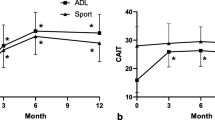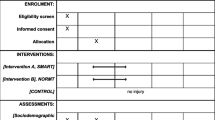Abstract
Introduction
Purpose of the study was the evaluation of the early functional outcome of patients with an acute ankle sprain treated either with a semirigid, variable, phase-adapted modular ankle orthosis or an invariable orthotic reference device.
Materials and methods
Forty-seven patients with acute ankle sprain grade II or more were included. In addition, 77 healthy controls as a reference were investigated. The injured subjects were treated with one of the two devices by random for 6 weeks. Ankle scores (FAOS, AOFAS) were taken at baseline after injury, 1 and 3 months after injury. Functional performance tests (balance platform, zig zag run, shuttle run, vertical drop jump) were performed at 1 and 3 months after injury.
Results
No significant score differences could be found between the two intervention groups except for achieving a preinjury activity level after 3 months only in the modular orthosis group. Postural functional performances (balance test) also showed no significant differences whereas the results of the agility tests revealed small but significant better results in the modular orthosis group in comparison to the invariable orthosis group. Cohen’s effect sizes were high.
Conclusion
Differences between the two intervention groups were marginal and very small but significant and—regarding Cohen´s effect sizes—effective. Especially relating to functional performance, this might be a careful indication that a more effective strategy for promoting a protected, rapid recovery to physical activity after ankle sprains might be achieved by applying a phase-adapted ankle orthosis. Especially in athletic patients, phase-adapted orthosis should be further investigated and considered to ensure fully protected ligament healing as well as to regain early functional recovery.





Similar content being viewed by others
References
Lamb SE, Marsh JL, Hutton JL et al (2009) Mechanical supports for acute, severe ankle sprain: a pragmatic, multicentre, randomised controlled trial. Lancet 373:575–581
Kerkhoffs GMMJ, Struijs PAA, Marti RK et al (2002) Different functional treatment strategies for acute lateral ankle ligament injuries in adults. Cochrane Database Syst Rev 3:CD002938
Pijnenburg AC, Van Dijk CN, Bossuyt PM et al (2000) Treatment of ruptures of the lateral ankle ligaments: a meta-analysis. J Bone Joint Surg Am 82:761–773
Beynnon BD, Renström PA, Haugh L et al (2006) A prospective, randomized clinical investigation of the treatment of first-time ankle sprains. Am J Sports Med 34:1401–1412
Kaikkonen A, Kannus P, Järvinen M (1994) A performance test protocol and scoring scale for the evaluation of ankle injuries. Am J Sports Med 22:462–469
Kemler E, van de Port I, Backx F et al (2011) A systematic review on the treatment of acute ankle sprain: brace versus other functional treatment types. Sports Med 41:185–197
Van Rijn RM, van Os AG, Bernsen RMD et al (2008) What is the clinical course of acute ankle sprains? A systematic literature review. Am J Med 121(324–331):e6
Kerkhoffs GMMJ, Rowe BH, Assendelft WJJ et al (2002) Immobilisation and functional treatment for acute lateral ankle ligament injuries in adults. Cochrane Database Syst Rev 3:CD003762
Lynch SA, Renström PA (1999) Treatment of acute lateral ankle ligament rupture in the athlete. Conservative versus surgical treatment. Sports Med 27:61–71
Eechaute C, Vaes P, Duquet W (2008) Functional performance deficits in patients with CAI: validity of the multiple hop test. Clin J Sport Med 18:124–129
Safran MR, Zachazewski JE, Benedetti RS et al (1999) Lateral ankle sprains: a comprehensive review part 2: treatment and rehabilitation with an emphasis on the athlete. Med Sci Sports Exerc 31:S438–S447
Houglum PA (1992) Soft tissue healing and its impact on rehabilitation. J Sport Rehab 1:19–39
Best R, Brüggemann G-P, Petersen W et al (2011) Current and new concepts in the treatment of lateral ligament sprains in ankle distorsions. D Z Sport 62:57–62
Brüggemann G-P, Willwacher S, Pagani FCH et al (2009) Preventive effectiveness of the Malleo Tristep ankle orthosis: biomechanical evaluation. Orthop Tech 12:1–6
Gross MT, Ballard CL, Mears HG et al (1992) Comparison of Donjoy ankle ligament protector and Aircast Sport-Stirrup orthoses in restricting foot and ankle motion before and after exercise. J Orthop Sports Phys Ther 16:60–67
Richter M, Zech S, Geerling J et al (2006) A new foot and ankle outcome score: questionnaire based, subjective, visual-analogue-scale, validated and computerized. Foot Ankle Surg 12:191–199
Kitaoka HB, Alexander IJ, Adelaar RS et al (1994) Clinical rating systems for the ankle-hindfoot, midfoot, hallux, and lesser toes. Foot Ankle Int 15:349–353
Bosco C, Luthanen P, Komi P (1983) A simple method for measurement of mechanical power in jumping. Eur J Appl Physiol 20:273–282
Bocchinfuso C, Sitler MR, Kimura IF (1994) Effects of two semirigid prophylactic ankle stabilizers on speed, agility, and vertical jump. J Sport Rehab 3:125–134
Paris DL (1992) The effects of the Swede-O, New Cross, and McDavid ankle braces and adhesive ankle taping on speed, balance, agility, and vertical jump. J Athl Train 27:253–256
Beriau MR, Cox WB, Manning J (1994) Effects of ankle braces upon agility course performance in high school athletes. J Athl Train 29:224–230
Gross MT, Everts JR, Roberson SE et al (1994) Effect of Donjoy ankle ligament protector and Aircast Sport-Stirrup orthoses on functional performance. J Orthop Sports Phys Ther 19:150–156
Guskiewicz KM, Perrin DH (1996) Effect of orthotics on postural sway following inversion ankle sprain. J Orthop Sports Phys Ther 23:326–331
Hertel J, Denegar CR, Buckley WE et al (2001) Effect of rearfoot orthotics on postural sway after lateral ankle sprain. Arch Phys Med Rehabil 82:1000–1003
O’connor G, Martin AJ (2011) Acute ankle sprain: is there a best support? Eur J Emerg Med 18:225–230
Akbari M, Karimi H, Farahini H et al (2006) Balance problems after unilateral lateral ankle sprains. J Rehabil Res Dev 43:819–824
Mitchell A, Dyson R, Hale T et al (2008) Biomechanics of ankle instability. Part 2: Postural sway–reaction time relationship. Med Sci Sports Exerc 40:1522–1528
Ross SE, Guskiewicz KM (2004) Examination of static and dynamic postural stability in individuals with functionally stable and unstable ankles. Clin J Sport Med 14:332–338
Hals TM, Sitler MR, Mattacola CG (2000) Effect of a semi-rigid ankle stabilizer on performance in persons with functional ankle instability. J Orthop Sports Phys Ther 30:552–556
McKeon PO, Hertel J (2008) Systematic review of postural control and lateral ankle instability, part I: can deficits be detected with instrumented testing. J Athl Train 43:293–304
Hudson Z (2009) Rehabilitation and return to play after foot and ankle injuries in athletes. Sports Med Arthrosc 17:203–207
Boer J, Mueller O, Krauss I et al (2010) Reliability of a measurement technique to characterise standing properties and to quantify balance capabilities of healthy subjects on an unstable oscillatory platform (posturomed). Sportverl Sportschad 24:40–43
Olsen O-E, Myklebust G, Engebretsen L et al (2004) Injury mechanisms for anterior cruciate ligament injuries in team handball: a systematic video analysis. Am J Sports Med 32:1002–1012
Ambegaonkar JP, Redmond CJ, Winter C et al (2011) Ankle stabilizers affect agility but not vertical jump or dynamic balance performance. Foot Ankle Spec 4:354–360
Boyce SH, Quigley MA, Campbell S (2005) Management of ankle sprains: a randomised controlled trial of the treatment of inversion injuries using an elastic support bandage or an Aircast ankle brace. Br J Sports Med 39:91–96
Conflict of interest
The corresponding author as well as 4 coauthors are a member of a Clinical Excellence Research Circle (CEC) which—as an innovative and independent research circle—itself does not gain or lose financially of our study but which is financially sponsored by Otto Bock® HealthCare GmbH, Duderstadt, Germany. Furthermore, the corresponding author as well as 3 of the coauthors hold a patent for some particular principles of a phase adapted orthosis as well as some particular technical details (e.g. additional side splints) of the Malleo Tristep Orthosis®.
Author information
Authors and Affiliations
Corresponding author
Additional information
R. Best and C. Böhle contributed equally.
Rights and permissions
About this article
Cite this article
Best, R., Böhle, C., Schiffer, T. et al. Early functional outcome of two different orthotic concepts in ankle sprains: a randomized controlled trial. Arch Orthop Trauma Surg 135, 993–1001 (2015). https://doi.org/10.1007/s00402-015-2230-x
Received:
Published:
Issue Date:
DOI: https://doi.org/10.1007/s00402-015-2230-x




